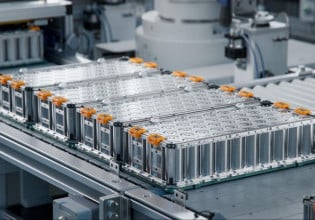Thermal Battery Technology Offers Low-cost Energy Storage for Industry
Rondo Energy has announced $60 million in funding from a syndicate of leading cleantech investors to advance their innovative heat battery energy storage solutions for industry.
Rondo Energy is developing a heat battery technology that uses common brick materials to store electricity generated from renewable sources such as wind and solar as heat.
Heat battery for industrial energy storage. Image used courtesy of Rondo Energy
Rondo has secured $60 million in funding from Microsoft’s Climate Innovation Fund and Aramco Ventures, along with leading climate tech investors Breakthrough Energy Ventures, Energy Impact Partners, and legendary investor John Doerr. The company will use the new funding to expand its international operations and fund the construction of new global heat energy storage projects.
Industry as the Largest Consumer of Energy
According to Rondo, industry is the largest consumer of energy globally. Industrial processes are used to make products like steel, cement, and consumer goods and are often powered by high-temperature heat. Industrial heat accounts for about one-quarter of total energy consumption globally and about one-quarter of global carbon emissions.
As outlined in the U.S. Department of Energy’s (DOE) Industrial Heat Shot Initiative, heavy industry has historically been one of the more difficult sectors to wean off carbon-based fuels, and heat storage technologies offer a potential solution.
Industry consumes one-quarter of global energy. Image used courtesy of Rondo Energy
Heat Battery Technology for Industrial Energy Storage
Electricity from renewable sources is becoming increasingly cost competitive, but industrial production requires reliable, on-demand energy. Rondo’s heat battery allows electricity produced during peak periods of renewable supply to be stored as heat for later use, either directly in high-temperature industrial processes or converted back to electricity.
The technology surrounding the heat battery is complex, but the concept is simple.
Heat battery stores energy generated from renewables. Image used courtesy of Rondo Energy
Electric heating elements (Joule heaters) are used to convert electricity from wind or solar production to heat. Heat from the elements is then transferred via thermal radiation to large stockpiles of brick (up to thousands of tons) that can store the heat for long periods of time with minimal energy loss (less than 1% per day).
Heat from the battery at tightly regulated temperatures can then be extracted on demand by circulating air across the bricks using an air blower. The heat can also be used to convert water to steam to drive turbines that convert the energy back to electricity, or to drive machinery and equipment.
The heat battery can be a cost-effective solution since it uses common brick materials that are produced in high quantities each year.
Heat battery for industrial steam, air, and electricity. Image used courtesy of Rondo Energy
Using TPV Cells to Convert Heat to Electricity
Rondo Energy is not the only company developing thermal battery solutions. Founded in 2017 by two alumni through the MIT Energy Initiative, Antora Energy is another start-up developing a similar thermal battery technology.
Similar to Rondo, Antora’s battery uses carbon blocks that are extremely stable and relatively inexpensive to produce to store heat produced from electric elements.
In addition to extracting heat directly from the battery for industrial processes, Antora has also developed innovations around thermophotovoltaic (TPV) cell technology. TPV cells allow heat from the battery to be converted directly to electricity, without the need for a steam turbine and generator.
TPV cells convert heat directly to electricity. Image used courtesy of Climate and Energy
According to Antora, their TPV technology achieves new levels of efficiency that make direct thermal-to-electric conversion more commercially viable.
The company opened a new manufacturing facility earlier this year that will be capable of producing 2 MW of their proprietary TPV cells each year.
Industrial Heat Shot Initiative
The Industrial Heat Shot Initiative is an effort by the U.S. DOE to reduce carbon emissions from heavy industries like steel, cement, and other industrial production.
The goal of the program is to develop cost-effective alternatives to carbon-based fuels for the generation of the high-temperature heat needed to drive these industrial processes. The initiative aims for an 85% reduction in carbon emissions from industrial heat by 2035.












